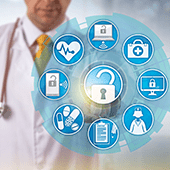
Educate your staff
A comprehensive data security training program is necessary to combat ever-evolving threats to the healthcare industry. Training should be done regularly and cover all the different areas of data security, including the different data breach methods employed by hackers. For instance, your employees should be educated on how to spot phishing attacks, which are the number one cause of data breaches, according to the 2020 Verizon Data Breach Investigations Report. Understanding how phishing works will help your employees recognize and avoid falling victim to such scams.
Enforce strict access policies
Implement access restriction policies to keep unauthorized users from getting their hands on PHI. This entails granting employees access to only the PHI they need to perform their tasks. For instance, accountants should not have access to data about patients’ health conditions. Similarly, physicians shouldn’t be able to see patients’ billing information.
Healthcare executives must also hold employees accountable for accessing PHI for no valid reason. Together with regular cybersecurity training, this will minimize the risk of data breaches resulting from insider threats.
Employ full-disk encryption
Full-disk encryption is an inexpensive and quick method to secure private information saved in computers and portable devices. It renders data indecipherable to users who don’t possess the matching decryption key. This means that even if one of your employees’ laptop or smartphone is lost or stolen, the thief won’t be able to access any encrypted PHI stored in it.
Build a resilient infrastructure
Malware is a blanket term for viruses, Trojans, and other harmful programs that cybercriminals use to damage systems and gain access to sensitive data. To ensure the security of PHI, your healthcare organization must build an IT infrastructure that is protected against malware of all kinds.
This involves setting up safeguards to keep malware and other threats at bay, such as advanced firewalls, intrusion prevention systems, and email filtering software. You should also consider network segregation and segmentation to block hackers’ attempts to penetrate your networks and steal PHI data.
If malware does manage to infiltrate your network, stop it from spreading by deploying next-gen anti-malware software that can detect and quarantine any signs of a breach. If such systems fail, you’d also need a data backup and recovery plan so you can continue caring for your patients even during a major incident.
Implement physical security measures
Many healthcare organizations still rely on paper-based PHI and store these in file cabinets. Secure these valuable assets by installing physical security controls, such as surveillance cameras and card entry systems, in the areas of your facility where records are stored. You should also implement strict record log-out procedures, which will help ensure that only authorized personnel can access records that contain sensitive data and that these are returned promptly.
To learn more about how you can secure PHI and other digital assets, drop us a line today. Our team of professionals can provide you with the knowledge and assistance you need.

You must be logged in to post a comment.